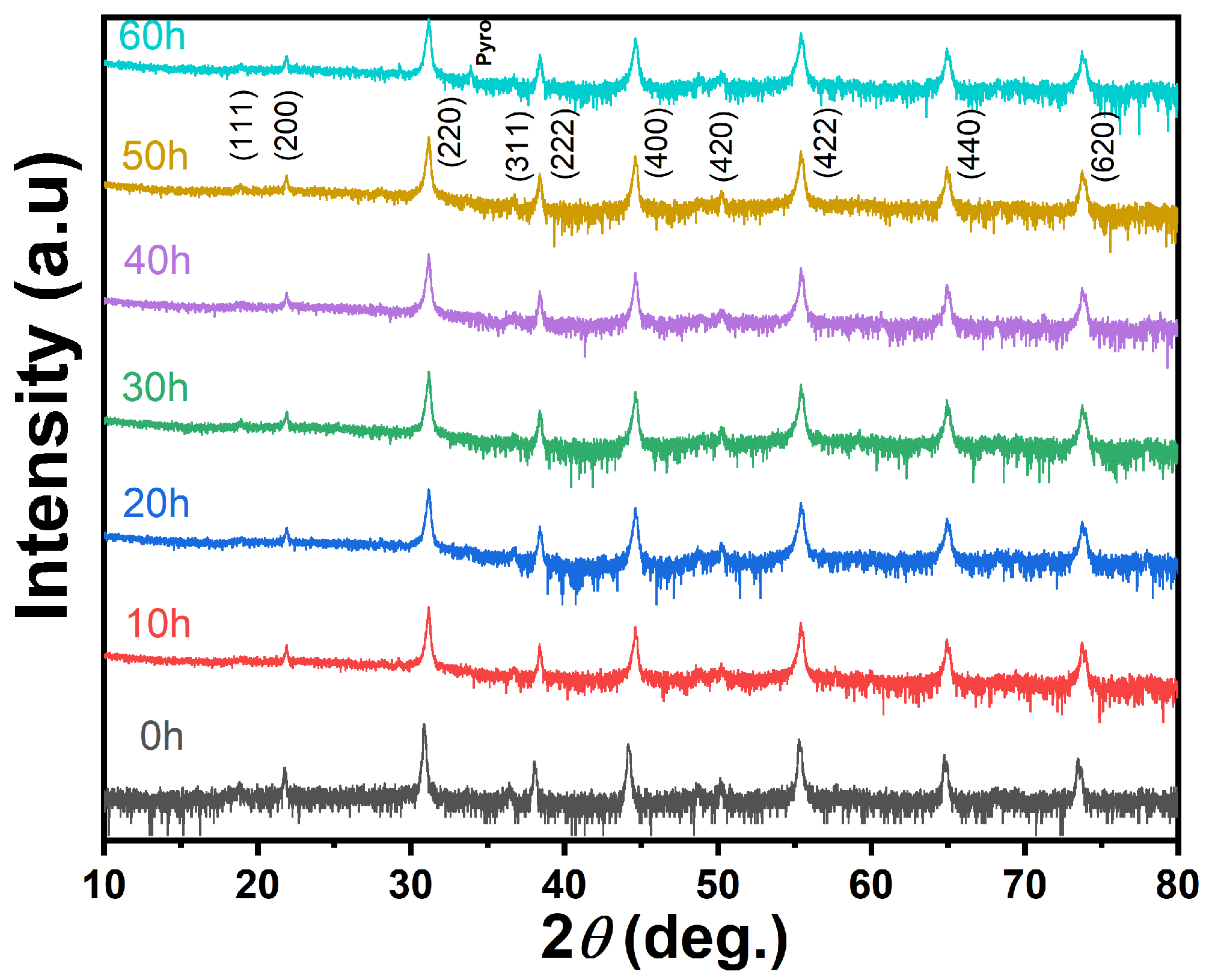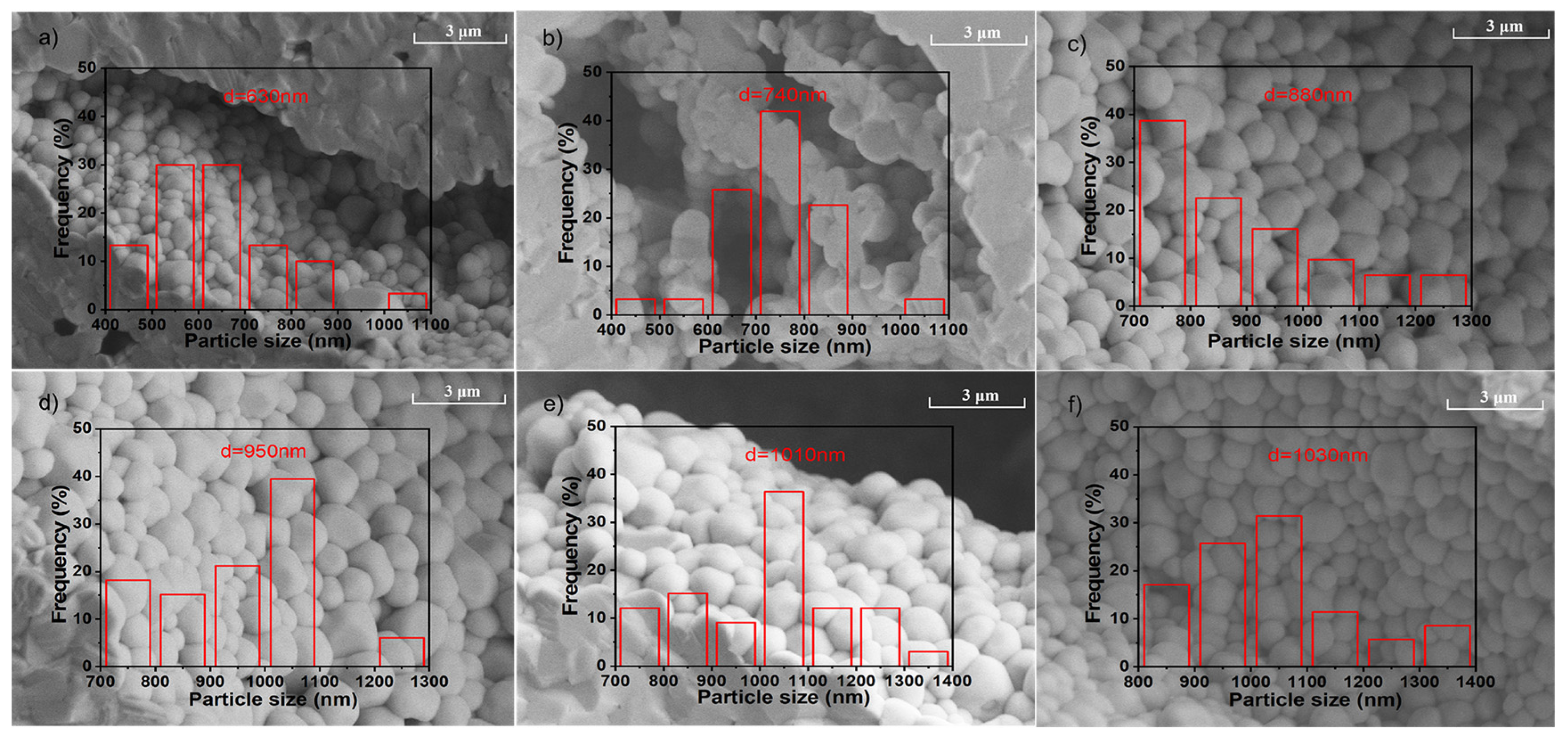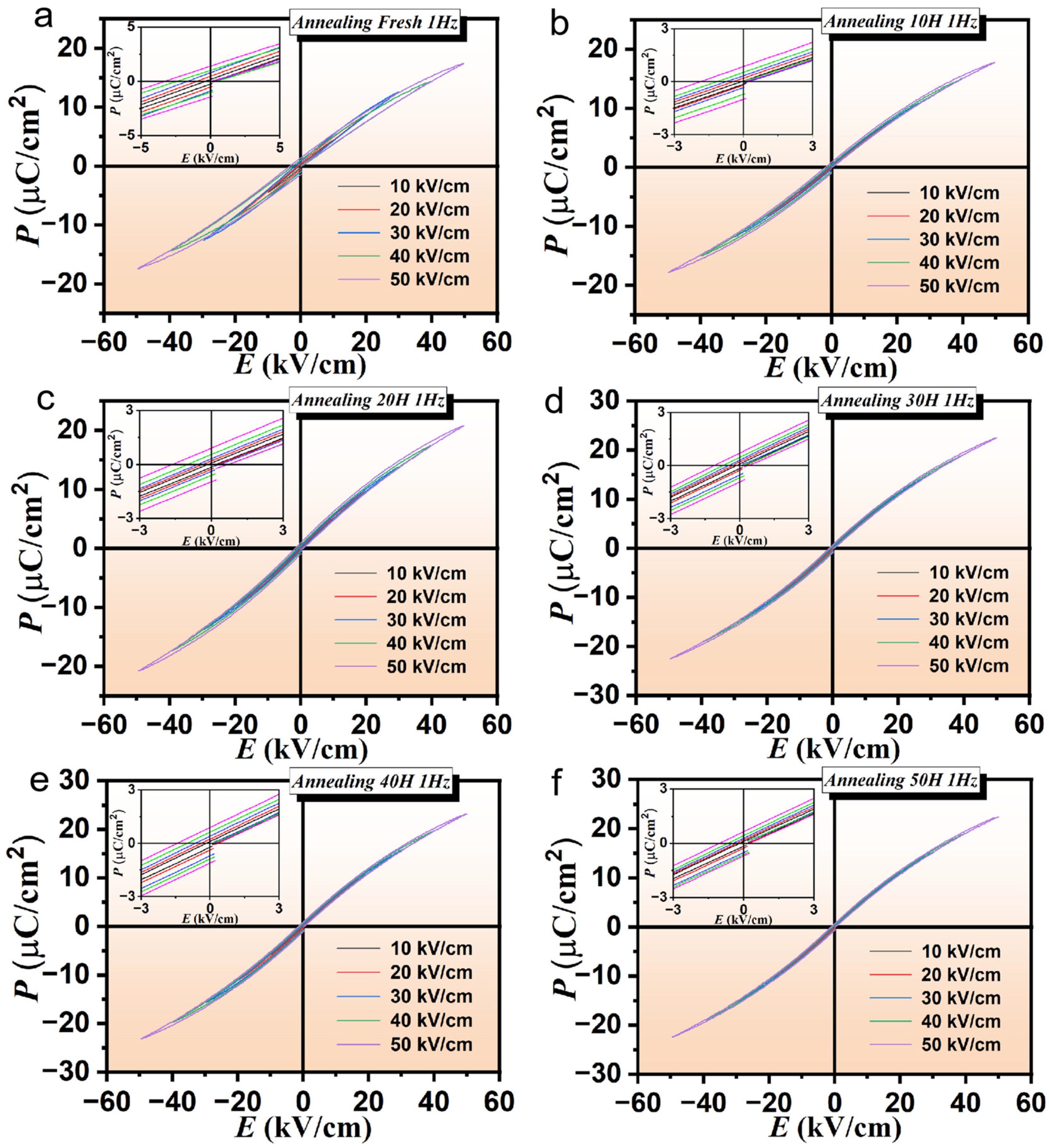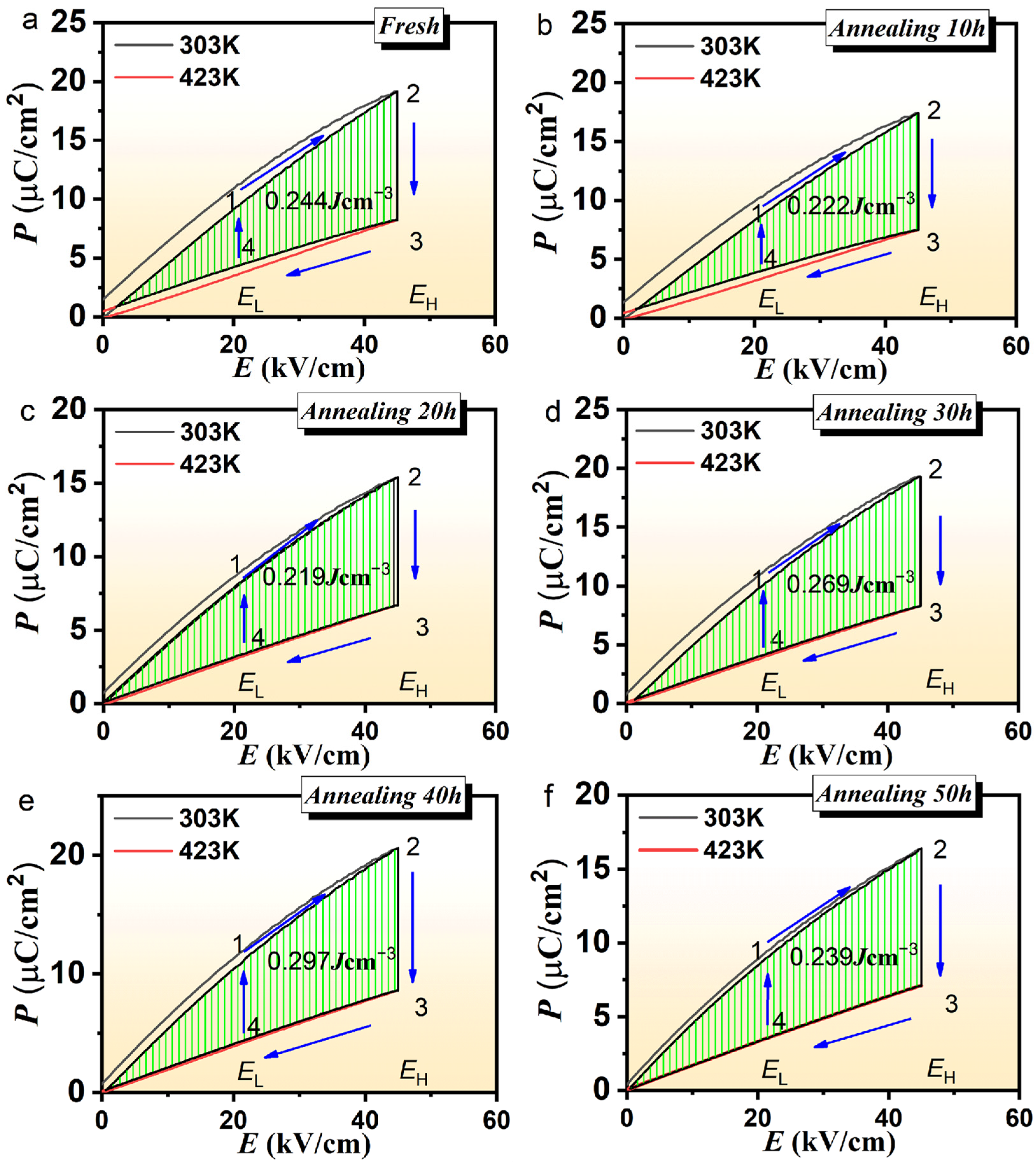Performance Optimization of Pb0.97La0.03Sc0.45Ta0.45Ti0.1O3 Ceramics by Annealing Process
Abstract
1. Introduction
2. Experimental Process
2.1. Fabrication
2.2. Characterization
3. Results and Discussion
3.1. Structure
3.2. Ferroelectric Properties
3.3. Electrocaloric Effect (EC)
3.4. Energy Harvesting Performance
3.5. Energy Storage Performance
4. Conclusions
Supplementary Materials
Author Contributions
Funding
Institutional Review Board Statement
Informed Consent Statement
Data Availability Statement
Conflicts of Interest
References
- Fuflyigin, V.; Salley, E.; Vakhutinsky, P.; Osinsky, A.; Zhao, J.; Gergis, I.; Whiteaker, K. Free-standing films of PbSc0.5Ta0.5O3 for uncooled infrared detectors. Appl. Phys. Lett. 2001, 78, 365–369. [Google Scholar] [CrossRef]
- Li, J.; Liu, B.; Liang, C.; Wan, L.; Wei, W.; Gao, H.; Li, M.; Li, Y.; Ding, W.; Qu, H.; et al. Fully self-powered electrocaloric cooling/heating with triboelectric nanogenerator. Nano Energy 2022, 101, 2211–2219. [Google Scholar] [CrossRef]
- Wang, Y.; Zhang, Z.; Tomoyasu, U.; Michael, B.; Sakyo, H.; Joseph, L.; Jamie, K.; David, S. A high-performance solid-state electrocaloric cooling system. Science 2020, 370, 129–133. [Google Scholar] [CrossRef] [PubMed]
- Alberta, E.F.; Bhalla, A.S. A Processing and electrical property investigation of the solid solution: (x)Pb(In1/2Nb1/2)O3−(1−x)Pb(Sc1/2Ta1/2)O3. Ferroelectrics 1996, 188, 95–107. [Google Scholar] [CrossRef]
- Brinkman, K.; Wang, Y.; Su, D.; Tagantsev, A.; Setter, N. The impact of chemical ordering on the dielectric properties of lead scandium tantalate Pb(Sc1/2Ta1/2)O3 thin films. J. Appl. Phys. 2007, 102, 044110. [Google Scholar] [CrossRef]
- Liu, H.; Wang, J.; Wang, J.; Jiang, H.; Hu, X.; Dong, H. Dielectric and piezoelectric properties of lanthanum-modified 0.55Pb(Sc1/2Ta1/2)O3−0.45PbTiO3 ceramics. J. Eur. Ceram. Soc. 2000, 20, 2337–2346. [Google Scholar] [CrossRef]
- Liu, W.; Wang, G.; Cao, S.; Mao, C.; Yao, C.; Cao, F.; Dong, X. The Phase Transition Behavior of (1−x)Pb(Sc0.5Ta0.5)O3−(x)PbHfO3. Ceramics. J. Am. Ceram. Soc. 2011, 94, 2530–2534. [Google Scholar] [CrossRef]
- Frenkel, A.; Pease, D.; Giniewicz, J.; Stern, E.; Brewe, D.; Daniel, M.; Budnick, J. Concentration-dependent short-range order in the relaxor ferroelectric (1−x)Pb(Sc,Ta)O3−xPbTiO3. Phys. Rev. B 2004, 70, 014106. [Google Scholar] [CrossRef]
- Liu, D.; Chen, H. Low-temperature preparation of perovskite Pb(Sc0.5Ta0.5)O3 thin films using MOCVD. Mater. Lett. 1996, 28, 17–20. [Google Scholar] [CrossRef]
- Hong, Z.; Ke, X.; Wang, D.; Yang, S.; Reng, X.; Wang, Y. Role of point defects in the formation of relaxor ferroelectrics. Acta Mater. 2022, 225, 117558. [Google Scholar] [CrossRef]
- Zhang, S.; Li, F.; Jiang, X.; Kim, J.; Luo, J.; Geng, X. Advantages and challenges of relaxor-PbTiO3 ferroelectric crystals for electroacoustic transducers—A review. Prog. Mater Sci. 2015, 68, 1–66. [Google Scholar] [CrossRef] [PubMed]
- Li, F.; Cabral, M.J.; Xu, B.; Cheng, Z.; Dickey, E.C.; LeBeau, J.M.; Wang, J.; Luo, J.; Taylor, S.; Hackenberger, W.; et al. Giant piezoelectricity of Sm-doped Pb(Mg1/3Nb2/3)O3-PbTiO3 single crystals. Science 2019, 364, 264–268. [Google Scholar] [CrossRef]
- Yue, X.; Xiao, D.; Chao, J.; Yuan, X.; Yu, G.; Xiong, X.; Wei, L.; Zhu, J. The crystalline and dielectric properties of (1−x)Pb(Sc1/2Ta1/2)O3–(x)PbTiO3 ceramics prepared by one-step-sintering-method. Ceram. Int. 2004, 30, 1905–1908. [Google Scholar] [CrossRef]
- Giniewicz, J.R.; Bhalla, A.S.; Cross, L.E. Variable structural ordering in lead scandium tantalate-lead titanate materials. Ferroelectrics 1998, 211, 281–297. [Google Scholar] [CrossRef]
- Choudhary, R.; Mal, J. Diffuse phase transition in Cs-modified PLZT ferroelectrics. Mater. Sci. Eng. B 2002, 90, 1–6. [Google Scholar] [CrossRef]
- Garten, L.M.; Burch, M.; Gupta, A.S.; Haislmaier, R.; Gopalan, V.; Dickey, E.C.; McKinstry, S.T. Relaxor Ferroelectric Behavior in Barium Strontium Titanate. J. Am. Ceram. Soc. 2016, 99, 1645–1650. [Google Scholar] [CrossRef]
- Correa, M.; Kumar, A.; Katiyar, R.S. Investigation of frequency dependent and independent dielectric maxima in relaxor ferroelectric thin films. Appl. Phys. Lett. 2007, 91, 082905. [Google Scholar] [CrossRef]
- Peng, B.; Fan, H.; Zhang, Q. A Giant Electrocaloric Effect in Nanoscale Antiferroelectric and Ferroelectric Phases Coexisting in a Relaxor Pb0.8Ba0.2ZrO3 Thin Film at Room Temperature. Adv. Funct. 2013, 23, 2987–2992. [Google Scholar] [CrossRef]
- Peng, B.; Zhang, Q.; Gang, B.; Leighton, G.; Shaw, C.; Milne, S.J.; Zou, B.; Sun, W.; Huang, H.; Wang, Z. Phase-transition induced giant negative electrocaloric effect in a lead-free relaxor ferroelectric thin film. Energy Environ. Sci. 2019, 12, 1708–1717. [Google Scholar] [CrossRef]
- Alpay, S.P.; Mantese, J.; Trolier-McKinstry, S.; Zhang, Q.; Whatmore, R.W. Next-generation electrocaloric and pyroelectric materials for solid-state electrothermal energy interconversion. Mater. Res. Soc. 2014, 39, 1009. [Google Scholar] [CrossRef]
- Zhang, W.; Yang, J.; Wang, F.; Chen, X.; Mao, H. Enhanced dielectric properties of La-doped 0.75BaTiO3-0.25Bi(Mg0.5Ti0.5)O3 ceramics for X9R-MLCC application. Ceram. Int. 2021, 47, 4486–4492. [Google Scholar] [CrossRef]
- Cao, Y.; Lin, J.; Shi, Y.; Li, G.; Shi, C.; Zhu, K.; Ge, G.; Chen, C.; Yan, F.; Yang, W.; et al. High Piezoelectricity in Eco-Friendly NaNbO3-Based Ferroelectric Relaxor Ceramics via Phase and Domain Engineering. ACS Appl. Mater. Interfaces 2023, 15, 5399–5410. [Google Scholar] [CrossRef]
- Liu, H.; Shi, X.; Yao, Y.; Luo, H.; Li, Q.; Huang, H.; Qi, H.; Zhang, Y.; Ren, Y.; Shelly, D.K.; et al. Emergence of high piezoelectricity from competing local polar order-disorder in relaxor ferroelectrics. Nat. Commun. 2023, 14, 1007. [Google Scholar] [CrossRef]
- Liu, Y.; Yang, T.; Wang, H. Effect of La doping on structure and dielectric properties of PLZST antiferroelectric ceramics. J. Mater. Sci. Mater. Electron. 2020, 31, 1509–1514. [Google Scholar] [CrossRef]
- Xu, J.; He, B. Structure and properties of La-doped Ba0.67Sr0.33TiO3 environmental ceramics. Mater. Lett. 2019, 235, 168–171. [Google Scholar] [CrossRef]
- Li, L.; Xu, M.; Zhang, Q.; Chen, P.; Wang, N.; Xiong, D.; Peng, B.; Liu, L. Electrocaloric effect in La-doped BNT-6BT relaxor ferroelectric ceramics. Ceram. Int. 2017, 44, 343–350. [Google Scholar] [CrossRef]
- Sahoo, B.; Panda, P.K. Effect of lanthanum, neodymium on piezoelectric, dielectric and ferroelectric properties of PZT. J. Adv. Ceram. 2013, 2, 37–41. [Google Scholar] [CrossRef]
- Qiang, H.; Xu, Z. Enhanced energy storage properties of La-doped Pb0.99Nb0.02(Zr0.85Sn0.13Ti0.02)0.98O3 antiferroelectric ceramics. J. Mater. Sci. Mater. Electron. 2020, 31, 14921–14929. [Google Scholar] [CrossRef]
- Ma, Z.; Zhang, Y.; Lu, C.; Qin, Y.; Lv, Z.; Lu, S. Synthesis and properties of La-doped PMN–PT transparent ferroelectric ceramics. J. Mater. Sci. Mater. Electron. 2018, 29, 6985–6990. [Google Scholar] [CrossRef]
- Li, J.; Wang, Y.; Yang, X. Processing bulk insulating CaTiO3 into a high-performance thermoelectric materia. Chem. Eng. J. 2022, 428, 131121. [Google Scholar] [CrossRef]
- Maier, B.J.; Welsch, A.M.; Mihailova, B.; Angel, R.J.; Bismayer, U. Effect of La doping on the ferroic order in Pb-based perovskite-type relaxor ferroelectrics. Phys. Rev. B 2011, 83, 134106. [Google Scholar] [CrossRef]
- Levi, R.D.; Tsur, Y. The Effect of Oxygen Vacancies in the Early Stages of BaTiO3 Nanopowder Sintering. Adv. Mater. 2005, 17, 1606–1608. [Google Scholar] [CrossRef]
- Zaman, A.; Hussain, A.; Malik, R.A.; Maqbool, A.; Kim, M.H. Dielectric and electromechanical properties of LiNbO3-modified (BiNa)TiO3−(BaCa)TiO3 lead-free piezoceramics. J. Phys. D Appl. Phys. 2016, 49, 175301. [Google Scholar] [CrossRef]
- Chan, W.; Xu, Z.; Hung, T.; Chen, H. Effect of La substitution on phase transitions in lead zirconate stannate titanate (55/35/10) ceramics. J. Appl. Phys. 2004, 96, 6606–6610. [Google Scholar] [CrossRef]
- Dan, Y.; Zou, K.; Chen, G.; Yu, Y.; Zhang, Y.; Zhang, Q.; Lu, Y.; Zhang, Q.; He, Y. Superior energy-storage properties in (Pb,La)(Zr,Sn,Ti)O3 antiferroelectric ceramics with appropriate La content. Ceram. Int. 2019, 45, 11375–11381. [Google Scholar] [CrossRef]
- Xu, Z.; Dai, X.; Li, J.; Viehland, D. Coexistence of incommensurate antiferroelectric and relaxorlike ferroelectric orderings in high Zrcontent Lamodified lead zirconate titanate ceramics. Appl. Phys. Lett. 1996, 68, 1628–1630. [Google Scholar] [CrossRef]
- Osbond, P.C.; Whatmore, R.W. High dielectric constant ceramics in the PbSc0.5Ta0.5O3-PbZrO3 and PbSc0.5Ta0.5O3-PbTiO3 systems. J. Mater. Sci. 1993, 28, 1377–1384. [Google Scholar] [CrossRef]
- Perumal, R.N.; Athikesavan, V. Investigations on electrical and energy storage behaviour of PZN-PT, PMN-PT, PZN–PMN-PT piezoelectric solid solutions. J. Mater. Sci. Mater. Electron. 2019, 30, 902–913. [Google Scholar] [CrossRef]
- Burton, B.P.; Cohen, R.E. Nonempirical calculation of the Pb(Sc0.5Ta0.5)O3-PbTiO3 quasibinary phase diagram. Phys. Rev. B 1995, 52, 792–797. [Google Scholar] [CrossRef]
- Crossley, S.; Nair, B.; Whatmore, R.W.; Moya, X.; Mathur, N.D. Eletrocaloric Cooling Cycles in Lead Scandium Tantalate with True Regeneration via Field Variation. Phys. Rev. X 2019, 9, 041002. [Google Scholar] [CrossRef]
- Nair, B.; Usui, T.; Crossley, S.; Kurdi, S.; Guzman-Verri, G.G.; Moya, X.; Hirose, S.; Mathur, N.D. Large electrocaloric effects in oxide multilayer capacitors over a wide temperature range. Nature 2019, 575, 468. [Google Scholar] [CrossRef] [PubMed]
- Crossley, S.; Whatmore, R.W.; Mathur, N.D.; Moya, X. Quasi-indirect measurement of electrocaloric temperature change in PbSc0.5Ta0.5O3 via comparison of adiabatic and isothermal electrical polarization data. APL Mater. 2021, 9, 010701. [Google Scholar] [CrossRef]
- Peng, B.; Fan, H.; Zhang, Q. High Tunability in (111)-Oriented Relaxor Pb0.8Ba0.2ZrO3 Thin Film with Antiferroelectric and Ferroelectric Two-Phase Coexistence. J. Am. Ceram. Soc. 2013, 96, 1852–1856. [Google Scholar] [CrossRef]
- Peng, B.; Zhang, Q.; Lyu, Y.; Liu, L.; Lou, X.; Shaw, C.; Huang, H.; Wang, Z. Thermal strain induced large electrocaloric effect of relaxor thin film on LaNiO3/Pt composite electrode with the coexistence of nanoscale antiferroelectric and ferroelectric phases in a broad temperature range. Nano Energy 2018, 47, 285–293. [Google Scholar] [CrossRef]
- Olsen, R.B.; Briscoe, J.M.; Bruno, D.A.; Butler, W.F. A pyroelectric energy converter which employs regeneration. Ferroelectrics 1981, 38, 975. [Google Scholar] [CrossRef]
- Olsen, R.B.; Brown, D.D. High efficieincy direct conversion of heat to electrical energy-related pyroelectric measurements. Ferroelectrics 1982, 40, 17–27. [Google Scholar] [CrossRef]
- Olsen, R.B.; Bruno, D.A.; Briscoe, J.M.; Dullea, J. Cascaded pyroelectric energy converter. Ferroelectrics 1984, 59, 205–219. [Google Scholar] [CrossRef]
- Kreisel, J.; Bouvier, P.; Maglione, M.; Dkhil, B.; Simon, A. High-Pressure Raman Investigation of the Pb-Free Relaxor BaTi0.65Zr0.35O3. Phys. Rev. B 2004, 69, 092104. [Google Scholar] [CrossRef]







Disclaimer/Publisher’s Note: The statements, opinions and data contained in all publications are solely those of the individual author(s) and contributor(s) and not of MDPI and/or the editor(s). MDPI and/or the editor(s) disclaim responsibility for any injury to people or property resulting from any ideas, methods, instructions or products referred to in the content. |
© 2023 by the authors. Licensee MDPI, Basel, Switzerland. This article is an open access article distributed under the terms and conditions of the Creative Commons Attribution (CC BY) license (https://creativecommons.org/licenses/by/4.0/).
Share and Cite
Su, Z.; Wan, L.; Mo, F.; Li, J.; Liu, B.; Liang, C.; Xu, J.; Talwar, D.N.; Li, H.; Yao, H. Performance Optimization of Pb0.97La0.03Sc0.45Ta0.45Ti0.1O3 Ceramics by Annealing Process. Materials 2023, 16, 4479. https://doi.org/10.3390/ma16124479
Su Z, Wan L, Mo F, Li J, Liu B, Liang C, Xu J, Talwar DN, Li H, Yao H. Performance Optimization of Pb0.97La0.03Sc0.45Ta0.45Ti0.1O3 Ceramics by Annealing Process. Materials. 2023; 16(12):4479. https://doi.org/10.3390/ma16124479
Chicago/Turabian StyleSu, Zihan, Lingyu Wan, Fenglai Mo, Jiayu Li, Boxun Liu, Chuangjian Liang, Jinsong Xu, Devki N. Talwar, Hang Li, and Huilu Yao. 2023. "Performance Optimization of Pb0.97La0.03Sc0.45Ta0.45Ti0.1O3 Ceramics by Annealing Process" Materials 16, no. 12: 4479. https://doi.org/10.3390/ma16124479
APA StyleSu, Z., Wan, L., Mo, F., Li, J., Liu, B., Liang, C., Xu, J., Talwar, D. N., Li, H., & Yao, H. (2023). Performance Optimization of Pb0.97La0.03Sc0.45Ta0.45Ti0.1O3 Ceramics by Annealing Process. Materials, 16(12), 4479. https://doi.org/10.3390/ma16124479






